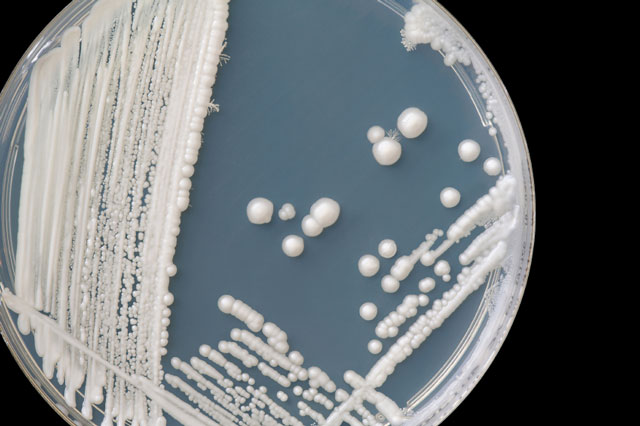
Yeast infections aren’t just a concern for women. We all have small amounts of Candida (the type of yeast that causes this infection) in our bodies, but an overgrowth of this yeast may result in an uncomfortable infection. These fungal infections can be found on your skin, genitals, throat, mouth, and even in your blood. In fact, some forms of diaper rash are actually caused by yeast infections.
A yeast infection is a more specific term for candidiasis, the fungal infection that results from too much Candida in the body. If the infection occurs in the mouth or throat, it is commonly called thrush. If it is located in the genitals, it is known as a yeast infection. And if the yeast infection enters the bloodstream, it is called invasive candidiasis. The symptoms, testing, and risk factors vary depending on where the yeast infection is located.
Thrush
Thrush is an overgrowth of Candida in the mouth, throat, or esophagus. It is most commonly found in the very young (babies less than one month old), the elderly, and people with weakened immune systems. Candida organisms thrive in warm, moist places like the mouth, so people who wear dentures may be more likely to get thrush. Cancer patients often undergo treatments that weaken the immune system, so they are also more susceptible to thrush. It is rarely found in healthy adults.
The telltale symptom of thrush is white patches on the tongue and in the mouth. Your mouth may appear red, and you might have soreness and difficulty swallowing. Oral thrush can also cause cracking at the corners of the mouth. It is usually diagnosed based on your symptoms. The doctor may perform a cell culture, but a positive result alone wouldn’t be enough for a diagnosis, as some levels of Candida are found in every human mouth. Once diagnosed, thrush is easily treated with prescription antifungal medication.
Genital Yeast Infection
Nearly 75% of women will get at least one yeast infection in their lifetime. Changes in hormonal balance or vaginal acidity can cause Candida to multiply, resulting in a yeast infection. Pregnant women or those taking hormone therapy are more at risk due to higher estrogen levels. Diabetes or HIV can also increase your risk. Although it is rarer, men can get yeast infections, particularly if they are not circumcised. Symptoms of a yeast infection in men include a red rash on the penis and an itching or burning sensation on the head of the penis.
Vaginal yeast infections can cause extreme itchiness, soreness, and redness in the genital region. Normal vaginal discharge is transparent or cloudy white, but a yeast infection can cause thick, white discharge with a cottage cheese-like consistency. Sexual intercourse may be painful, and if you believe you might have a yeast infection, you should refrain from sex until you’ve seen a doctor, as yeast infections can be passed between sexual partners.
A genital yeast infection is diagnosed via a pelvic exam and cell culture. A sample of vaginal secretions may be examined to see if an abnormally high number of Candida organisms are present. Some symptoms of a yeast infection are similar to those of a urinary tract infection or an STD, so you shouldn’t self-diagnose. Although over-the-counter treatments are available, studies show that two-thirds of women who buy these medicines don’t actually have a yeast infection. If you use this medication when you don’t have a yeast infection, the yeast can become resistant to it, making it much more difficult to treat if you do get an infection. Once the doctor confirms the diagnosis, he will suggest some type of antifungal treatment. This can be a cream, tablet, ointment, or suppository.
Invasive Candidiasis
Although Candida is prevalent in the human body, it should not be in the bloodstream. When Candida enters the bloodstream, it can then spread to other parts of the body, causing an infection. Like oral candidiasis, this infection is rare in adults without risk factors. People who are most at risk include intensive care unit patients, surgical patients, people with a catheter, very low birth weight infants (under 2.2 pounds), and people with weakened immune systems (such as HIV/AIDS patients or people undergoing cancer treatments). This infection is most often seen in people who are or have recently been hospitalized.
Symptoms of invasive candidiasis depend on where the infection has spread in the body. The most common symptoms are fever and chills that do not improve after treatment with antibiotics. It is diagnosed through a blood culture, and treatment requires several weeks of oral or intravenous antifungal medication. This is a very serious condition that can lead to organ failure and even death if untreated.
A yeast infection of any kind – oral, genital, or invasive – is not something to be taken lightly. If you are experiencing any of the symptoms listed here, go to your local FastMed Urgent Care so a health care provider can examine you and provide the correct diagnosis and treatment.
Resources
Candidiasis, Centers for Disease Control and Prevention
Candidiasis (Yeast Infection), WebMD
Vaginal Infections, Student Health Services UC San Diego
Vaginal Yeast Infections Fact Sheet, U.S. Department of Health and Human Services